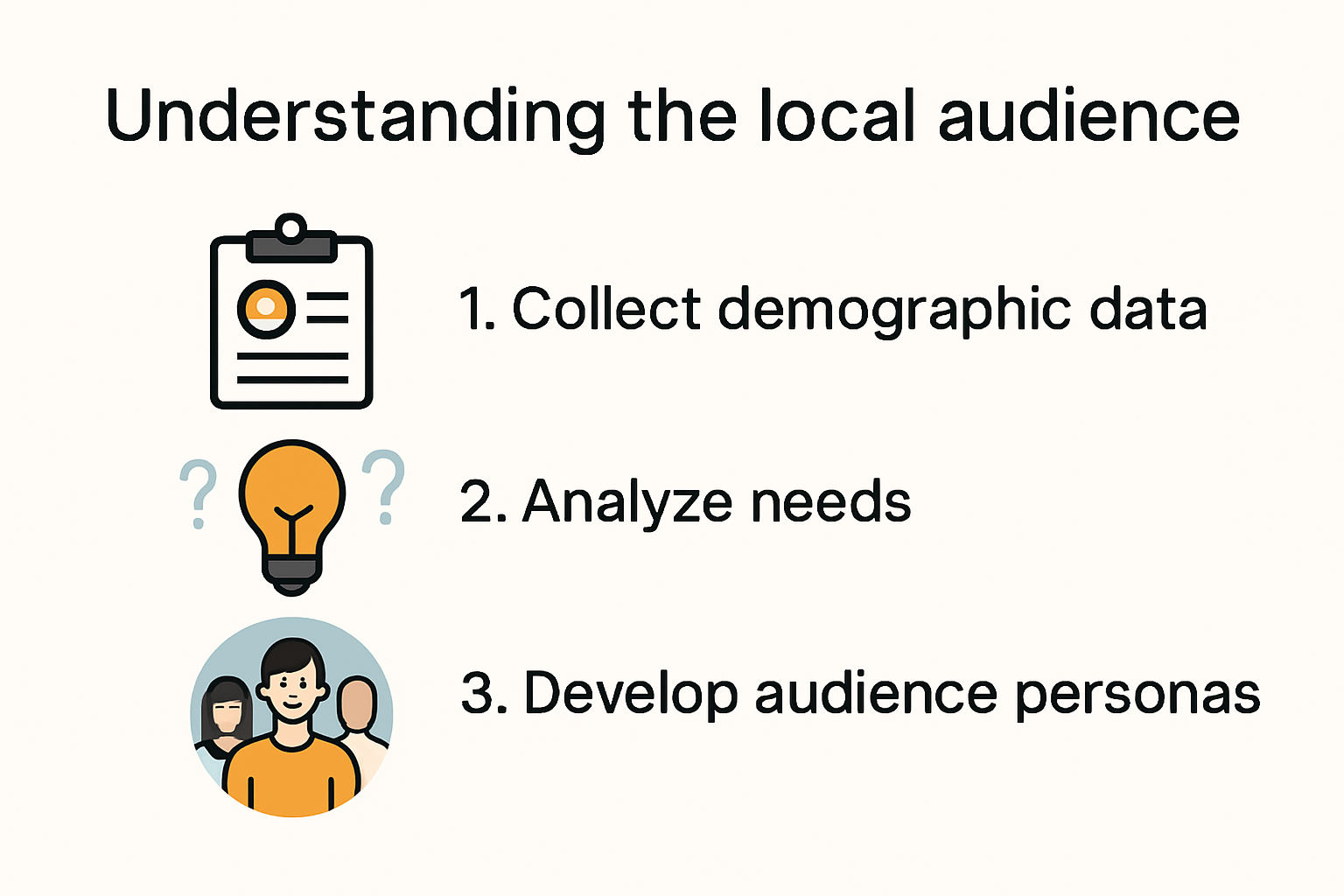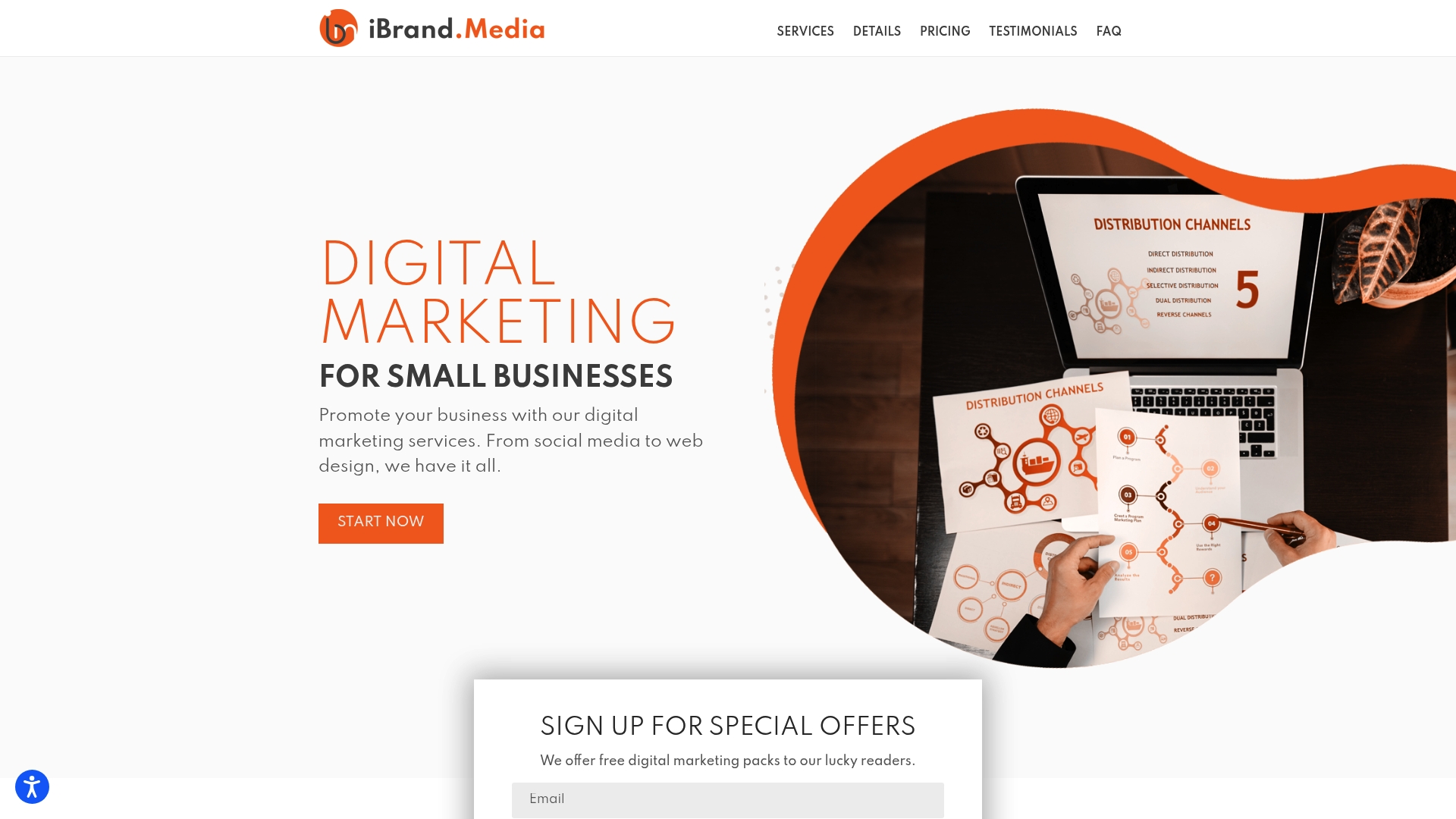Small businesses everywhere want social media posts that actually get customers interested and talking. You might think eye-catching visuals or clever promos are the secret sauce. Turns out, visual content is shared 40 times more often than text-only posts but the boldest growth happens when you tap into your community’s own stories and local quirks. This shift unlocks a direct line from clicks to loyal customers.
Table of Contents
- Understanding What Engages Your Local Audience
- Proven Content Ideas For Small Businesses
- Simple Tools And Tactics For Standout Posts
- Measuring Success And Adjusting Your Strategy
Quick Summary
| Takeaway | Explanation |
|---|---|
| Understand your local audience’s demographics. | Use analytics tools to gather data on age, gender, and interests. This helps create tailored content that resonates with your community. |
| Create culturally relevant content strategies. | Focus on local culture, events, and testimonials in your posts to connect authentically with your audience. |
| Engage actively with your community online. | Respond to comments promptly and host interactive events to foster genuine relationships with followers. |
| Prioritize high-quality visual content. | Use tools like Canva for graphics and smartphone apps for videos to enhance your social media presence visually. |
| Regularly measure and refine your content strategy. | Analyze performance metrics to adjust your strategies quarterly, ensuring continual improvement based on data insights. |
Understanding What Engages Your Local Audience
Successful social content starts with deeply understanding your local audience’s unique preferences, behaviors, and motivations. Small businesses must move beyond generic marketing approaches and develop targeted strategies that resonate authentically with their community.
Mapping Local Audience Demographics and Interests
Understanding your local audience requires comprehensive research and strategic analysis. Social Media Examiner reports that 68% of small businesses struggle to accurately identify their target audience’s specific interests. This challenge demands a systematic approach to demographic mapping.
Start by collecting granular data about your local community. Utilize analytics tools from platforms like Facebook and Instagram to gain insights into age ranges, gender distributions, income levels, and online behaviors. Local businesses can leverage these tools to create precise audience personas that reflect their community’s characteristics.
Consider conducting brief local surveys or analyzing customer feedback to understand deeper psychological drivers. What motivates your local customers? What challenges do they face? These insights help craft content that speaks directly to their experiences.

Creating Culturally Relevant Content Strategies
Sprout Social indicates that 72% of consumers prefer engaging with brands that demonstrate genuine local understanding. This means moving beyond generic posts to create content that reflects local culture, events, and shared experiences.
Develop content strategies that celebrate local nuances. Highlight community events, showcase local landmarks, or share stories that resonate with neighborhood dynamics. For service-based businesses like home contractors or medical professionals, this might mean addressing specific local challenges or seasonal considerations unique to your area.
Visual storytelling becomes crucial. Use imagery and video that authentically represent your local community. A plumbing business might share posts about weatherproofing homes during local seasonal changes. A med spa could showcase treatments tailored to local lifestyle needs.
Engagement Through Authentic Community Connection
True engagement transcends mere content creation. It requires building genuine relationships. Host interactive social media events, respond promptly to comments, and create content that invites dialogue. Hootsuite’s research reveals that businesses responding within one hour of customer interaction see 7x higher engagement rates.
Encourage user-generated content by creating local hashtags, running community-focused contests, or featuring customer stories. This approach transforms passive followers into active community participants. A banquet hall might invite clients to share wedding or event photos, creating a collaborative storytelling platform.
Remember that creating engaging social content is an ongoing process of listening, adapting, and connecting. By understanding your local audience’s unique characteristics and consistently delivering value, small businesses can build robust, loyal online communities that translate into tangible business growth.
For more insights on refining your local social media strategy, read our comprehensive guide on increasing engagement.
Proven Content Ideas for Small Businesses
Content creation remains a critical strategy for small businesses seeking to establish a strong online presence and connect meaningfully with their target audience. The right content can transform casual followers into loyal customers and brand advocates.
Behind-the-Scenes and Authentic Storytelling
Oklahoma State University Extension emphasizes the importance of content that goes beyond direct promotion. Their research highlights the 80/20 rule: 80% of content should inform and entertain, while only 20% should be promotional. This approach builds trust and genuine connections.
Small businesses can leverage behind-the-scenes content to humanize their brand. Share glimpses of daily operations, introduce team members, or showcase the craftsmanship behind your services. A home contractor might create short videos explaining complex renovation processes. A med spa could share preparation techniques for specific treatments, giving followers an insider perspective.
Storytelling becomes a powerful tool when it reveals the human element of your business. Highlight customer success stories, share your business’s origin story, or demonstrate how your services solve real community problems. These narratives create emotional connections that transcend traditional marketing approaches.
Educational and Problem-Solving Content
The U.S. Small Business Administration recommends developing content that provides genuine value to your audience. This means creating posts that educate, solve problems, or offer practical insights related to your industry.
For service-based businesses, this could mean creating quick tutorial videos, infographics explaining complex processes, or weekly tips relevant to your expertise. A plumbing business might create short videos about preventing pipe damage. A dentist could share oral health maintenance tips. These content pieces position your brand as a knowledgeable, helpful resource.
Consider developing an editorial calendar that aligns content with seasonal events, local happenings, or industry trends. This approach ensures consistent, timely, and relevant content that keeps your audience engaged and demonstrates your business’s active community involvement.
Interactive and User-Generated Content Strategies
A temporal analysis study on social media visibility underscores the importance of creating content that encourages direct audience participation. Interactive content not only boosts engagement but also extends your brand’s organic reach.
Implement strategies that invite audience interaction. Host Q&A sessions, create polls about local preferences, or run contests that encourage followers to share their experiences. A banquet hall could ask followers to vote on their favorite event theme. A home service business might invite customers to share home improvement before-and-after photos.
User-generated content transforms followers from passive consumers to active community participants. Showcase customer testimonials, feature client projects, or create hashtag campaigns that encourage sharing. This approach builds social proof and creates a sense of community around your brand.
Remember that creating engaging content is an ongoing process of listening, experimenting, and adapting. Explore our comprehensive guide to social media marketing for more advanced strategies tailored to small businesses.
Simple Tools and Tactics for Standout Posts
Creating standout social media content requires strategic tools and creative tactics that help small businesses cut through the digital noise and capture audience attention. The right approach can transform ordinary posts into engaging, memorable experiences that drive connection and growth.
Visual Content Creation and Enhancement
Adobe’s Visual Content Marketing Report reveals that visual content is 40 times more likely to be shared across social platforms compared to text-only posts. Small businesses must prioritize high-quality visual strategies to maximize engagement.
Utilize free and affordable design tools like Canva, which offers user-friendly templates specifically designed for social media platforms. These tools enable businesses to create professional-looking graphics without extensive design expertise. Focus on creating consistent visual branding through color schemes, fonts, and graphic styles that reflect your business’s personality.
For video content, smartphone cameras and simple editing apps like InShot or CapCut can produce compelling short-form videos. Consider creating quick tutorial videos, behind-the-scenes glimpses, or customer testimonial highlights that showcase your business’s unique value proposition.
Strategic Posting and Timing Techniques
Sprout Social’s Engagement Research indicates that posting frequency and timing significantly impact content visibility. Different social platforms have optimal posting windows that vary by industry and target audience.
Develop a consistent posting schedule using social media management tools like Hootsuite or Buffer. These platforms allow businesses to schedule content in advance, ensuring regular engagement without constant manual intervention. Analyze your audience’s online activity patterns and schedule posts during peak engagement times.
Experiment with content variations to understand what resonates most. Track metrics like likes, shares, and comments to refine your strategy. A/B testing different post formats, captions, and visual styles can reveal powerful insights about audience preferences.
Comparison Table: Social Media Content Types and Their Benefits
To help small businesses choose the right content for their social channels, here’s a comparison of common content types and their main benefits, as discussed in the article.
| Content Type | Example Activities | Main Benefits |
|---|---|---|
| Behind-the-Scenes | Show daily operations, introduce team, process videos | Builds trust, humanizes brand |
| Educational / Problem-Solving | Tutorials, infographics, expert tips | Offers value, positions business as expert |
| Interactive / User-Generated | Contests, polls, Q&A, hashtag campaigns, testimonials | Boosts engagement, builds community |
| Visual Content | Photos, graphics, short-form video | Higher share rates, more attention |
| Culturally Relevant & Local | Event highlights, local stories, community-focused posts | Builds local loyalty, deepens relevance |
Leveraging Platform-Specific Features
Each social media platform offers unique features that can enhance content engagement. Instagram’s Stories and Reels, Facebook’s Live videos, and TikTok’s short-form content provide dynamic ways to connect with audiences.
For local businesses, geo-tagging and location-based hashtags can increase visibility within community networks. A home service business might use location tags to highlight local projects. A med spa could create region-specific content that speaks directly to local clientele.
Encourage audience interaction through platform-specific engagement tools. Create polls, host Q&A sessions, or use interactive stickers that invite followers to participate. These features transform passive content consumption into active community engagement.
Remember that social media success is an ongoing experiment. Learn more about advanced social media management strategies to continually refine your approach and stay ahead of digital marketing trends.
Measuring Success and Adjusting Your Strategy
Measuring social media performance is not just about collecting numbers. It is a strategic process of understanding audience behavior, identifying successful content patterns, and making data-driven decisions that continuously improve your social media approach.
Understanding Key Performance Indicators
Google Analytics provides comprehensive insights into social media performance metrics that small businesses should track. These metrics go beyond simple follower counts and delve into meaningful engagement measurements.
Critical performance indicators include engagement rate, which measures likes, comments, and shares relative to your total follower count. Reach metrics demonstrate how many unique users viewed your content. Conversion rates track how many social media interactions translate into actual business inquiries or sales.
For service-based businesses like home contractors or med spas, track metrics specific to your industry. A plumber might measure how many service calls originate from social media posts. A dentist could track appointment bookings generated through social content.
Measuring Social Media Performance: Key Metrics Table
To clarify the most important metrics discussed, here’s a summary table of key social media performance indicators for small businesses.
| Metric | What It Measures | Example Use |
|---|---|---|
| Engagement Rate | Likes, comments, shares per follower | Track content popularity and audience resonance |
| Reach | Number of unique users who saw your content | Evaluate brand awareness and post visibility |
| Conversion Rate | Actions taken (inquiries, sales) from social posts | Track leads, bookings, sales generated by content |
| Platform Growth | Change in follower or subscriber count | Assess ongoing channel growth and retention |
| User-Generated Content | Number of community submissions, mentions, shares | Measure community involvement and social proof |
Utilizing Advanced Analytics Tools
Hootsuite’s Social Media Benchmarks Report recommends leveraging specialized analytics platforms that provide deeper insights than native platform tools. Tools like Sprout Social, Buffer, and native platform analytics offer comprehensive dashboards that break down performance across multiple channels.
These advanced tools help small businesses understand audience demographics, peak engagement times, and content performance. Demographic insights reveal who is actually interacting with your content, allowing for more targeted future strategies. Engagement time analysis shows when your audience is most receptive to your posts.
Consider implementing cross-platform tracking to understand how content performs differently on various social media platforms. A post that performs exceptionally on Instagram might have minimal traction on LinkedIn, indicating the need for platform-specific content strategies.
Continuous Strategy Refinement
Harvard Business Review’s Digital Marketing Research emphasizes the importance of continuous learning and adaptation in social media marketing. Successful businesses treat their social media strategy as a living document, constantly evolving based on performance data.
Implement a quarterly review process where you analyze your top-performing content, identify emerging trends, and adjust your content strategy accordingly. Look for patterns in post types, topics, and formats that generate the most engagement. Use these insights to refine future content creation.
Do not be afraid to experiment. A/B testing different content styles, posting times, and messaging can reveal unexpected insights about your audience’s preferences. Track these experiments meticulously and be prepared to pivot quickly based on the data.
Remember that social media success is a journey of continuous improvement. Discover more about developing a comprehensive digital marketing strategy to stay ahead in the rapidly evolving digital landscape.

Frequently Asked Questions
How can I better understand my local audience for social media?
To better understand your local audience, utilize analytics tools from social media platforms to gather data on demographics such as age, gender, and interests. Conduct surveys or analyze customer feedback to identify their motivations and challenges, allowing you to create tailored content that resonates with them.
What types of content are most effective for small businesses on social media?
Effective content types for small businesses include behind-the-scenes storytelling that humanizes your brand, educational posts that provide valuable insights or problem-solving tips, and interactive content that encourages audience participation through polls, contests, or user-generated content campaigns.
How can I create visually appealing social media posts?
You can create visually appealing posts using design tools like Canva for graphics and editing apps like InShot or CapCut for videos. Prioritize high-quality visuals that align with your brand’s aesthetic, and ensure your content is consistent in terms of color schemes and styles for better brand recognition.
What metrics should I focus on to measure the success of my social media content?
Key performance metrics to focus on include engagement rate (likes, comments, shares), reach (unique users who viewed your content), conversion rate (actions taken from posts), and user-generated content submissions. These indicators help evaluate the effectiveness of your social media strategies.
Ready to Turn Social Engagement Into Real Business Growth?
Many small businesses struggle to turn local insights and creative content ideas into actual customer action. If you feel stuck getting your social media posts noticed but not seeing followers become loyal clients, you are not alone. This guide has shown how powerful storytelling, visual content, and authentic community engagement can be, yet it is easy to get overwhelmed finding the right tools, strategies, and timing to see measurable results on your own.

You do not have to figure it out by yourself. Let ibrand.media help you build a cost-effective online presence with a custom social media plan designed for your local market. See how our proven methods in Uncategorized | Ibrandmedia can deliver targeted strategies that drive real engagement, faster. Visit ibrand.media today to request a free marketing evaluation and discover how your social content can start generating more leads immediately.
Recommended
- Social Media Marketing for Businesses: Strategies That Work in 2025 | Ibrandmedia
- Practical Social Media Marketing Tips for Small Business Owners 2025 | Ibrandmedia
- How Social Media Works for Small Businesses in 2025 | Ibrandmedia
- Top Benefits of Social Media Presence for Small Businesses 2025 | Ibrandmedia

Recent Comments